Pinterest, the digital mood board we all love, can be more than just a place to find inspiration for your next DIY project or dream vacation. It can actually be a powerful tool to generate income. But unlike some platforms where you get paid directly for posting, Pinterest works a little differently. If you’re wondering how to make money on Pinterest, you’re in the right place. In this comprehensive guide, we’ll walk through the essential steps to turn your Pinterest presence into a lucrative source of income.
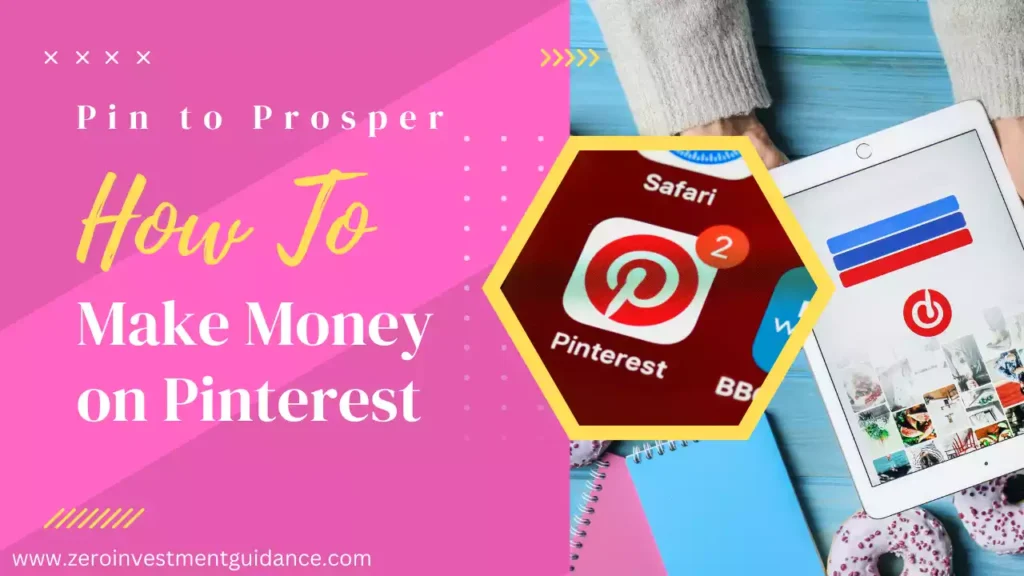
How to Make Money on Pinterest: A Comprehensive Guide
What is Pinterest and Why Use It for Making Money?
Pinterest is a visual discovery platform where users can find ideas and inspiration for various interests, from home decor to recipes, fashion, and more. Think of it as a virtual pinboard where people save and share ideas they love. Each idea is represented by a “Pin,” which is an image or video that links back to the original source, be it a blog, an online store, or any other website.
So, why should you consider using Pinterest to make money? Here are a few compelling reasons:
1. Visual Appeal and Engagement
- Pinterest’s visual nature makes it incredibly engaging.
- People are naturally drawn to images and videos, making Pinterest a perfect platform for showcasing products, services, and content in an appealing way.
- Users often come to Pinterest with a buying mindset, searching for ideas and products to purchase, making it a goldmine for businesses and marketers.
2. High Traffic Potential
- Pinterest boasts over 400 million active users worldwide.
- That’s a huge audience! With the right strategies, you can tap into this vast user base and drive significant traffic to your website, blog, or online store.
- More traffic means more potential customers and, ultimately, more revenue.
3. Longevity of Pins
- Unlike other social media posts that quickly get buried in feeds, Pins on Pinterest have a much longer lifespan.
- A well-crafted Pin can continue to drive traffic and generate engagement for months, even years, after it’s been posted.
- This long-term visibility is invaluable for sustained growth and income.
4. Niche Targeting
- Pinterest allows you to target specific niches effectively.
- Whether you’re in fashion, home decor, fitness, or any other industry, you can create content tailored to your audience’s interests.
- This precision targeting increases the chances of reaching potential customers who are genuinely interested in what you offer.
5. Multiple Monetization Options
- Pinterest offers various ways to make money.
- You can engage in affiliate marketing, sell your products directly, promote your services, or collaborate with brands for sponsored content.
- The platform’s flexibility allows you to choose the monetization methods that best suit your business model and goals.
6. Pinterest SEO Benefits
- Pinterest operates like a search engine, allowing users to discover content through keywords and hashtags.
- By optimizing your Pins and boards for SEO, you can increase your visibility on the platform, making it easier for users to find and engage with your content.
- This organic reach can significantly boost your monetization efforts.
7. Integration with Other Platforms
- Pinterest seamlessly integrates with other social media platforms, blogs, and e-commerce sites.
- This integration makes it easy to share your content across multiple channels, amplifying your reach and driving more traffic to your monetization sources.
Overall, Pinterest is more than just a platform for sharing pretty pictures. It’s a powerful tool for businesses and individuals looking to make money online. Its visual appeal, high traffic potential, long-lasting Pins, niche targeting, diverse monetization options, SEO benefits, and integration capabilities make it an excellent choice for anyone looking to turn their passion into profit. So, if you’re ready to tap into Pinterest’s potential, let’s dive into the strategies that can help you succeed!
Setting Up Your Pinterest Account for Success
To make the most of Pinterest for your money-making ventures, setting up your account properly is crucial. Let’s break it down step by step to ensure your Pinterest business account is primed for success.
A. Creating a Pinterest Business Account
The first step in leveraging Pinterest for profit is creating a business account. A business account provides access to Pinterest Analytics, ads, and other tools designed to help you grow your presence and monetize your activities.
Step 1: Sign Up or Convert Your Personal Account
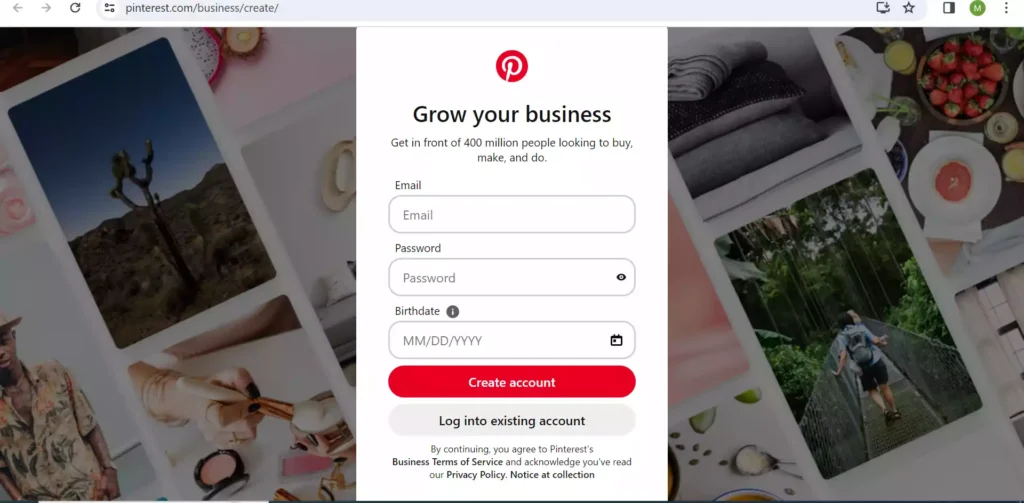
- If you’re new to Pinterest, go to the Pinterest homepage CLICK HERE, and click on “Sign Up.”
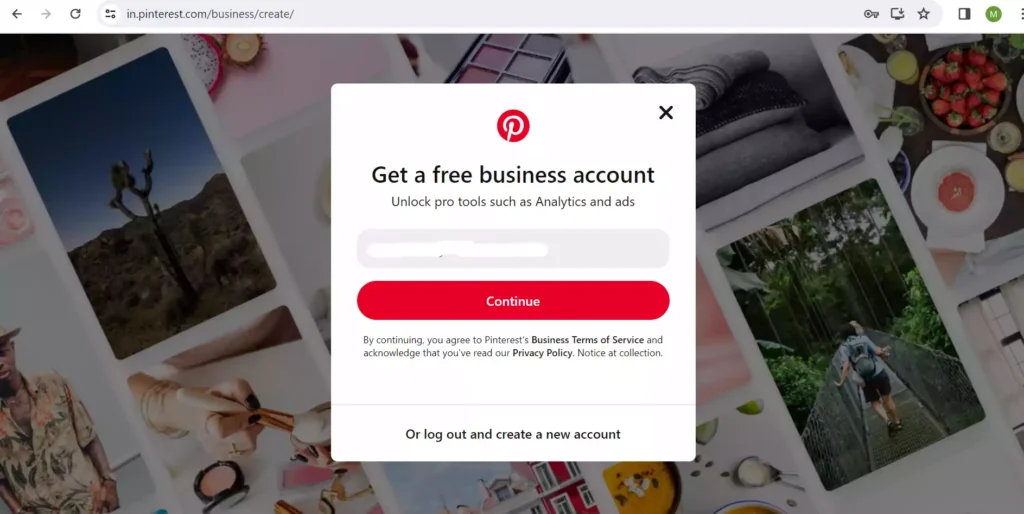
- If you already have a personal account, log in and go to “Settings.” Scroll down to “Account settings” and click on “Switch to a business account.”
Step 2: Complete Your Profile
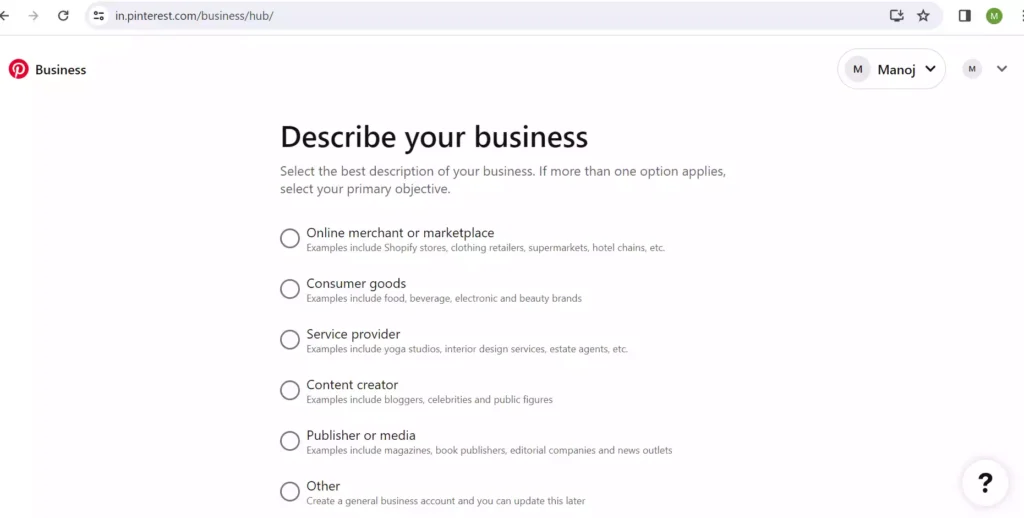
- Fill in your business name, choose the appropriate business category, and add your website link (if applicable).
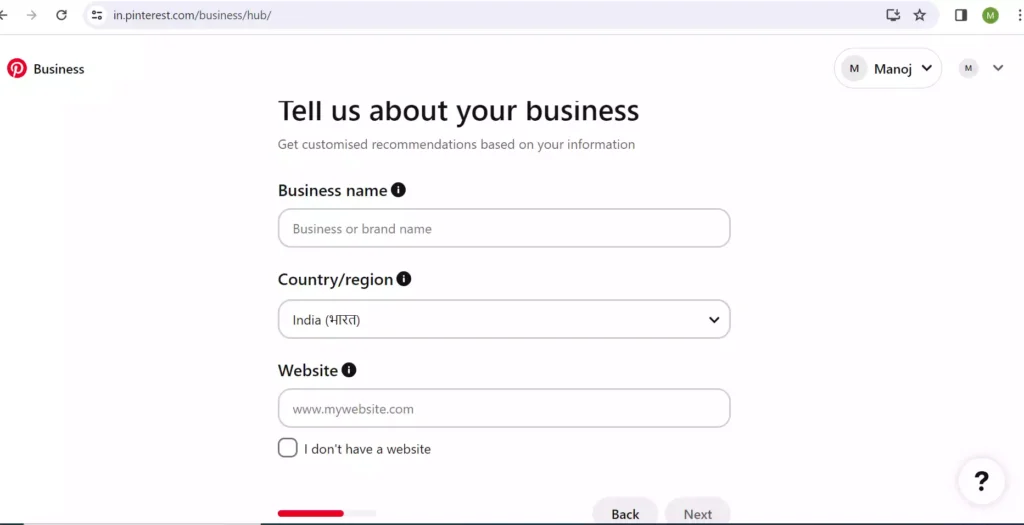
- Upload a profile picture or logo that represents your brand. This image will be visible on your profile and next to your pins.
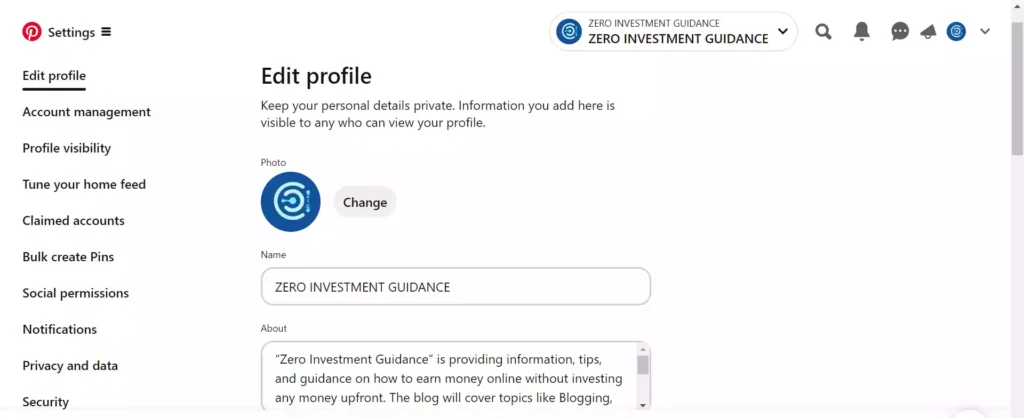
Step 3: Claim Your Website
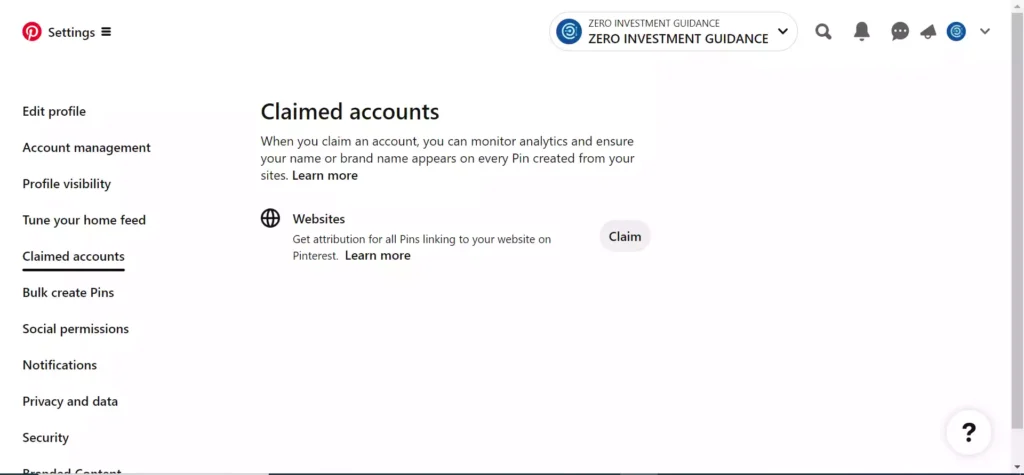
- In the settings, you’ll find an option to claim your website. This step involves adding a snippet of code to your website or confirming ownership via another method. Claiming your website enhances your profile’s credibility and unlocks additional features.
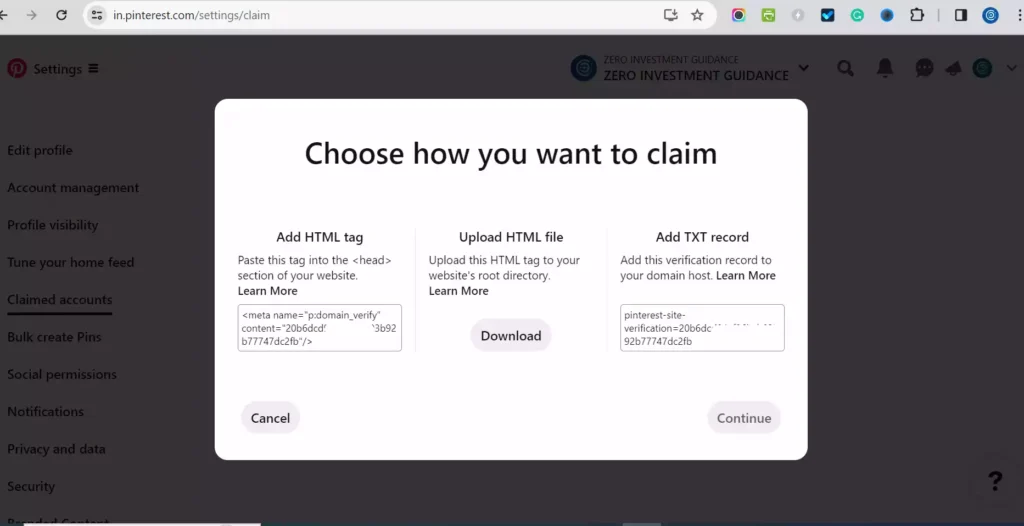
Step 4: Create Relevant Boards
- Start by creating boards that align with your business or content niche. Think of these boards as categories where you’ll organize your pins. For example, if you’re in the fashion industry, you might have boards for “Summer Outfits,” “Accessories,” or “Style Tips.”
- Write concise and keyword-rich descriptions for each board. These descriptions help Pinterest understand the content you’re curating and improve the discoverability of your boards.
B. Optimizing Your Profile
An optimized profile increases your chances of attracting and retaining followers, ultimately driving more traffic to your Pins.
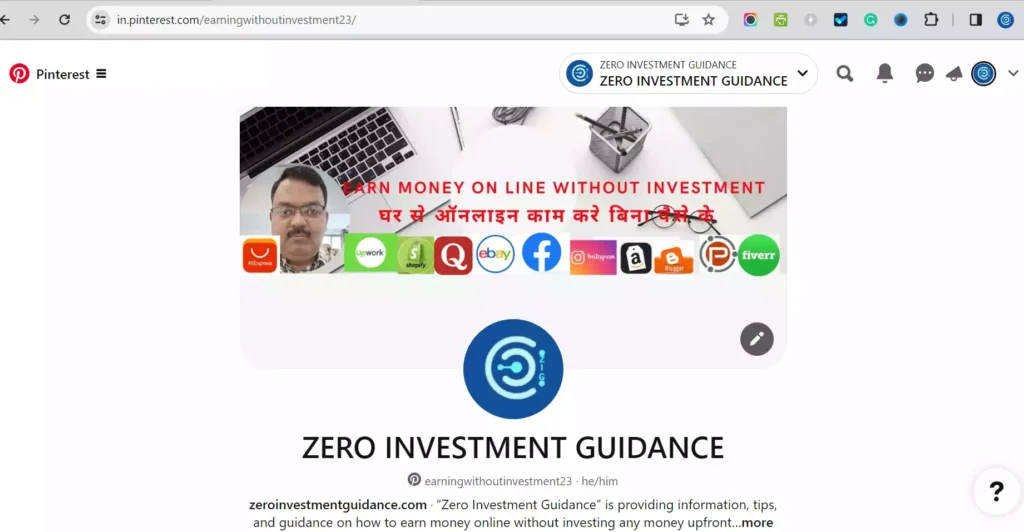
Profile Picture:
- Use a clear, high-quality logo or a professional photo. This helps with brand recognition.
Username and Handle:
- Choose a username and handle that reflect your brand. Consistency across social media platforms can help with brand recognition.
Bio:
- Your bio should be engaging and informative. Use keywords related to your niche to help people find you through search. Mention what value you provide and include a call to action, like visiting your website or following you for updates.
Board Organization:
- Create boards that categorize your content. Each board should have a clear, keyword-rich title and description. This helps users easily navigate your profile and find the content they are interested in.
C. Verify Your Account
- Verify your business account to gain access to additional features and build trust with your audience. Verification involves confirming your website or claiming your other social media accounts.
D. Set Up Pinterest Analytics
- Pinterest Analytics provides valuable insights into the performance of your pins and boards. To access analytics, you may need to wait a few days after setting up your business account to accumulate data.
E. Connect Other Social Media Accounts
- Link your Pinterest account to your other social media profiles, such as Instagram or Twitter. Cross-promoting your content across platforms can help expand your reach.
Congratulations! You’ve successfully set up your Pinterest business account. Now, focus on consistently creating high-quality, visually appealing pins and engaging with your audience to maximize the potential of your Pinterest presence. As you grow, regularly revisit your analytics to refine your strategy and adapt to the evolving interests of your audience.
Strategies for Making Money on Pinterest
Once your Pinterest account is set up for success, it’s time to dive into the various strategies you can use to start making money. Whether you’re looking to generate passive income or actively promote your business, Pinterest offers multiple monetization avenues.
Affiliate Marketing on Pinterest
Affiliate marketing is one of the easiest ways to make money on Pinterest. Here’s how you can get started:
Join Affiliate Programs:
- Sign up for affiliate programs relevant to your niche.
- Popular affiliate networks include Amazon Associates, ShareASale, and Commission Junction.
Create Affiliate Pins:
- Create high-quality, engaging Pins that link directly to your affiliate products.
- Make sure the Pin image is eye-catching and the description includes your affiliate link along with a compelling call-to-action.
Disclose Affiliate Relationships:
- Always disclose that your Pins contain affiliate links.
- This is both an ethical practice and a requirement by Pinterest’s policies.
- You can simply add a note in the Pin description like, “This post contains affiliate links.”
Monitor Performance:
- Use Pinterest Analytics to track the performance of your affiliate Pins.
- Identify which Pins are driving the most traffic and conversions, and focus on creating more content around those successful products.
Selling Your Own Products
Pinterest is a fantastic platform for driving sales of your own products, whether they’re physical items or digital downloads.
Set Up a Shop:
- If you have an online store, make sure it’s well-integrated with Pinterest.
- Platforms like Shopify and WooCommerce have built-in integrations that make it easy to sync your product catalog with Pinterest.
Create Product Pins:
- Use high-quality images and detailed descriptions for your product Pins.
- Make sure to include relevant keywords and a strong call-to-action, like “Shop Now” or “Learn More.”
Use Rich Pins:
- Rich Pins provide more context about an idea because they show extra information directly on the Pin.
- For products, this includes real-time pricing, availability, and where to buy. Set up Rich Pins by adding metadata to your website.
Promote Your Pins:
- Use Pinterest Ads to promote your product Pins to a larger audience.
- Promoted Pins can help you reach users who are not already following you, increasing your visibility and potential for sales.
Promoting Services and Courses
If you offer services or online courses, Pinterest can be a valuable tool for attracting clients and students.
Create Informative Content:
- Share valuable content that showcases your expertise.
- This could be blog posts, free guides, or tutorials related to your services or courses.
Design Attractive Pins:
- Use engaging visuals to promote your services or courses.
- Highlight key benefits and include a call-to-action encouraging users to learn more or sign up.
Lead Magnets:
- Offer free resources like e-books, checklists, or webinars in exchange for email sign-ups.
- This helps you build a mailing list of potential clients or students interested in your offerings.
Success Stories and Testimonials:
- Share Pins that feature testimonials or success stories from past clients or students.
- Social proof can be a powerful motivator for others to invest in your services or courses.
Sponsored Pins and Paid Partnerships
Collaborating with brands for sponsored content is another lucrative way to make money on Pinterest.
Build a Strong Profile:
- Brands are more likely to collaborate with influencers who have a strong, engaged following.
- Focus on creating high-quality content and growing your audience.
Reach Out to Brands:
- Don’t be afraid to pitch yourself to brands that align with your niche.
- Highlight your Pinterest statistics, audience demographics, and any previous successful collaborations.
Create Sponsored Content:
- When creating sponsored Pins, ensure they fit seamlessly with your regular content.
- Authenticity is key to maintaining your audience’s trust.
Disclosure and Compliance:
- Always disclose sponsored content to comply with legal requirements and Pinterest’s policies.
- Use hashtags like #sponsored or #ad in your Pin descriptions.
By leveraging these strategies, you can effectively monetize your Pinterest presence. Whether you choose to focus on affiliate marketing, selling your own products, promoting services, or collaborating with brands, there are plenty of opportunities to turn your Pinterest efforts into a profitable venture.
Creating Engaging Pins That Convert
Creating Pins that captivate your audience and drive conversions is essential for monetizing your Pinterest presence. Here’s how you can craft Pins that not only attract attention but also inspire action.
Design Tips for High-Converting Pins
The design of your Pins plays a crucial role in catching the eye of users as they scroll through their feeds. Here are some tips to create visually appealing and effective Pins:
High-Quality Images:
- Use high-resolution images that are clear and visually appealing. Blurry or pixelated images are a big no-no.
Vertical Orientation:
- Pins are vertically oriented, with the ideal ratio being 2:3 (e.g., 1000 x 1500 pixels). Vertical Pins take up more space in the feed, making them more likely to be noticed.
Bright and Contrasting Colors:
- Use bright, contrasting colors to make your Pins stand out. Avoid colors that blend into the background.
Readable Text Overlay:
- Include text overlays to convey the main message of your Pin quickly. Use large, easy-to-read fonts and ensure the text contrasts well with the background.
Branding:
- Incorporate your logo or website URL subtly into your Pins. This helps with brand recognition and ensures that your content is easily identifiable.
Consistent Style:
- Maintain a consistent style and theme across your Pins. This creates a cohesive look for your profile and makes your brand more recognizable.
Call to Action (CTA):
- Add a clear call to action in your Pin. Phrases like “Shop Now,” “Learn More,” or “Get Started” can encourage users to take the next step.
Crafting Compelling Pin Descriptions
An engaging Pin description can significantly impact the success of your Pins by providing context and encouraging clicks. Here’s how to craft compelling descriptions:
Keyword Integration:
- Use relevant keywords naturally in your descriptions to improve searchability. Think about what terms your target audience might use to find your content.
Detailed and Informative:
- Provide detailed descriptions that give users a clear understanding of what they’ll gain by clicking on your Pin. Include any important information that isn’t obvious from the image alone.
Engaging Language:
- Use engaging and conversational language. Ask questions, use exclamations, and address the reader directly to make your description more engaging.
Benefits and Value:
- Highlight the benefits and value of what you’re offering. Explain why users should care and what they’ll get out of clicking through to your content.
Hashtags:
- Include a few relevant hashtags to increase the discoverability of your Pins. Hashtags help categorize your content and make it easier for users to find.
Call to Action:
- Reinforce your call to action in the description. Encourage users to take the desired action, whether it’s visiting your website, signing up for a newsletter, or purchasing a product.
Using Rich Pins for Enhanced Visibility
Rich Pins provide more context and information directly on the Pin, making them more useful and engaging for users. There are several types of Rich Pins, including product, recipe, and article Pins. Here’s how to use them:
Set Up Rich Pins:
- To enable Rich Pins, you need to add specific meta tags to your website and validate your Pins through Pinterest.
- The process is straightforward, and Pinterest provides detailed instructions on how to get started.
Product Rich Pins:
- These are perfect for e-commerce businesses.
- They include real-time pricing, availability, and where to buy the product.
- This information can help users make informed purchasing decisions quickly.
Recipe Rich Pins:
- If you’re sharing recipes, these Pins include ingredients, cooking times, and serving sizes.
- This additional information can make your Pins more useful and likely to be saved and shared.
Article Rich Pins:
- For bloggers and content creators, article Pins include the headline, author, and a snippet of the article.
- This can entice users to click through and read the full post.
Up-to-Date Information:
- Rich Pins automatically update with any changes you make on your website.
- For example, if you change the price of a product, the Rich Pin will reflect that change, ensuring that users always see the most current information.
Enhanced Engagement:
- Rich Pins often have higher engagement rates because they provide more context and useful information upfront.
- Users are more likely to interact with content that they find valuable and informative.
By focusing on creating visually appealing designs, crafting compelling descriptions, and leveraging the power of Rich Pins, you can significantly enhance the effectiveness of your Pinterest marketing efforts. These elements work together to attract attention, provide value, and drive conversions, helping you achieve your monetization goals on Pinterest.
Growing Your Pinterest Audience
Expanding your Pinterest audience is key to maximizing your monetization efforts. The more people you reach, the higher your chances of driving traffic and generating income. Here are some strategies to grow your Pinterest audience effectively.
Building Boards and Pinning Strategies
Building well-organized boards and implementing smart pinning strategies can attract and retain followers.
Create Relevant Boards:
- Set up boards that reflect your niche and target audience’s interests.
- Each board should have a clear, keyword-rich title and description to help users find them through search.
Organize Your Boards:
- Arrange your boards in a logical order, with the most important or popular boards at the top of your profile.
- This makes it easier for visitors to navigate and find the content they’re interested in.
Pin Regularly:
- Consistency is crucial on Pinterest.
- Aim to pin at least once a day to keep your profile active.
- You can use scheduling tools like Tailwind to plan your Pins in advance and ensure regular posting.
Mix Your Content:
- Pin a mix of your own content and others’ Pins.
- This not only fills up your boards with valuable content but also increases your chances of being noticed by other users and gaining followers.
Optimize Pin Timing:
- Pinning at the right times can increase your visibility.
- Research shows that the best times to pin are often in the evening and on weekends when users are more active on the platform.
Engage with Trends:
- Stay updated with current trends and seasonal topics.
- Creating and pinning content that aligns with these trends can attract more viewers and increase engagement.
Utilizing Group Boards and Collaborations
Group boards and collaborations can significantly expand your reach and expose your content to a wider audience.
Join Relevant Group Boards:
- Search for group boards in your niche and request to join them.
- Pinning to group boards can get your content in front of a larger audience than your personal followers.
Create Your Own Group Board:
- If you have a decent following, consider creating your own group board.
- Invite other pinners in your niche to contribute. This can attract their followers to your profile as well.
Collaborate with Influencers:
- Partner with influencers or other content creators in your niche.
- Collaborations can include guest pins, joint boards, or cross-promotions.
- This mutual promotion can help both parties grow their audiences.
Share Other Contributors’ Content:
- Be an active participant in group boards by sharing others’ Pins as well.
- This fosters a sense of community and can encourage others to reciprocate by sharing your content.
Engage in Pinterest Communities:
- Pinterest Communities are groups centered around specific interests or topics.
- Joining and actively participating in these communities can help you connect with like-minded users and attract followers.
Engaging with Your Audience
Engagement is crucial for building a loyal and active following on Pinterest.
Respond to Comments:
- Take the time to respond to comments on your Pins.
- This shows that you value your audience’s input and encourages more interaction.
Ask Questions:
- Include questions in your Pin descriptions to spark conversation.
- This can increase engagement and make your Pins more interactive.
Host Contests and Giveaways:
- Contests and giveaways are great ways to boost engagement and attract new followers.
- Ask users to follow your account, repin your content, or tag friends to enter.
Encourage Saves and Shares:
- Remind your audience to save and share your Pins.
- The more your content is saved and shared, the more visibility it gains on the platform.
Utilize Pinterest Stories:
- Pinterest Stories are a newer feature that allows you to share temporary, engaging content.
- Use Stories to showcase behind-the-scenes looks, quick tips, or announcements to keep your audience engaged.
Monitor Analytics:
- Regularly check your Pinterest Analytics to understand what content resonates most with your audience.
- Use these insights to refine your strategy and create more of what your audience loves.
By building organized boards, pinning strategically, leveraging group boards and collaborations, and actively engaging with your audience, you can grow your Pinterest following significantly. A larger, more engaged audience will amplify your reach, drive more traffic, and enhance your ability to monetize your Pinterest efforts.
Analytics and Tracking Performance
Understanding and utilizing analytics is crucial for the success of your Pinterest marketing efforts. By tracking your performance, you can make data-driven decisions to optimize your strategies and improve your results.
Using Pinterest Analytics
Pinterest Analytics is a powerful tool that provides insights into how your content is performing on the platform. Here’s how to make the most of it:
Accessing Pinterest Analytics:
- To access Pinterest Analytics, log into your business account and click on the Analytics tab in the top left corner.
- You’ll find an overview of your profile’s performance.
Key Metrics to Monitor:
- Impressions: The number of times your Pins were seen.
- Engagements: The total number of engagements (clicks, saves, and close-ups) on your Pins.
- Link Clicks: The number of times users clicked on your Pins to visit your website or destination link.
- Saves: The number of times your Pins were saved to users’ boards.
- Audience Insights: Demographic information about your audience, such as age, gender, location, and interests.
Analyzing Top Performing Pins:
- Look at your top-performing Pins to understand what type of content resonates with your audience.
- Pay attention to the design, keywords, and topics of these Pins.
Board Performance:
- Check which boards are generating the most engagement and traffic.
- This can help you determine which topics and categories are most popular with your audience.
Trends Over Time:
- Use the timeline graphs to spot trends and patterns.
- For instance, you might notice a spike in engagement during certain times of the year, which can inform your future content planning.
Tools for Tracking Pin Performance
In addition to Pinterest Analytics, there are several third-party tools that can help you track and analyze your Pin performance more comprehensively:
- Tailwind is a Pinterest-approved scheduler and analytics tool.
- It provides detailed insights into your Pin performance, board growth, and optimal pinning times.
- Tailwind’s SmartLoop feature helps you recycle your best-performing Pins to keep them active and driving traffic.
- Integrate your Pinterest account with Google Analytics to track the traffic and conversions generated from your Pins.
- This will give you a broader view of how Pinterest fits into your overall marketing strategy.
- Hootsuite allows you to schedule and monitor your social media content across multiple platforms, including Pinterest.
- It offers analytics features to track your performance and engagement.
- Sprout Social provides in-depth analytics and reporting tools for Pinterest.
- It helps you understand your audience’s behavior, measure your content’s effectiveness, and improve your strategies.
- If you use Canva to design your Pins, you can access insights on your design performance.
- This helps you understand which design elements are most effective in capturing your audience’s attention.
Adjusting Strategies Based on Data
The key to successful Pinterest marketing is being adaptable and willing to adjust your strategies based on the data you collect. Here’s how to use your analytics to inform your approach:
Identify Patterns:
- Look for patterns in your data. Are certain types of Pins consistently performing better than others? Is there a specific time of day or week when your engagement peaks?
Refine Your Content:
- Use the insights from your top-performing Pins to create more of what works.
- Focus on the topics, designs, and keywords that generate the most engagement and traffic.
Optimize Underperforming Content:
- Identify Pins that are not performing well and experiment with changes.
- This could include updating the design, tweaking the description, or adjusting the keywords.
Test and Experiment:
- Continuously test new strategies to see what works best for your audience.
- This could involve experimenting with different types of content, varying your Pinning frequency, or trying new promotional tactics.
Monitor Competitors:
- Keep an eye on your competitors’ Pinterest activity.
- Analyze their top-performing content to gain insights and inspiration for your own strategy.
Adjust Based on Trends:
- Stay updated with Pinterest trends and adjust your content accordingly.
- Seasonal trends, popular keywords, and emerging topics can all influence your content strategy.
By leveraging Pinterest Analytics and other tracking tools, you can gain a deep understanding of your audience and content performance. Use this data to continually refine and optimize your Pinterest strategy, ensuring that you are effectively reaching and engaging your audience, driving traffic, and ultimately, making money on the platform.
Monetization Tips and Best Practices
Maximizing your income from Pinterest involves smart strategies, diversifying income streams, staying current with trends, and adhering to legal and policy guidelines. Here are some essential tips and best practices to help you succeed.
Diversifying Income Streams
Relying on a single income stream can be risky. Diversifying your income sources can provide more stability and increase your earning potential. Here’s how you can diversify:
- Promote products from multiple affiliate programs to spread the risk and find the best fit for your audience.
- Different products may resonate differently with your followers.
Selling Products:
- Offer a mix of physical and digital products.
- For instance, if you sell handmade crafts, you could also sell digital craft patterns or tutorials.
Online Courses and Ebooks:
- Share your expertise through paid online courses and ebooks.
- This not only provides a new income stream but also establishes you as an authority in your niche.
Sponsored Content:
- Work with various brands for sponsored Pins and posts.
- Make sure the brands align with your niche and audience interests for authentic collaborations.
Ad Revenue:
- Use platforms like Mediavine or AdThrive to display ads on your blog or website.
- Drive traffic from Pinterest to your site to increase ad impressions and revenue.
Consulting and Services:
- Offer consulting services or freelance work related to your expertise.
- For example, if you’re a Pinterest marketing expert, you could offer services to help others grow their Pinterest presence.
Staying Updated with Pinterest Trends
Pinterest is a dynamic platform, and staying updated with the latest trends can help you stay relevant and maximize your reach. Here’s how to keep up:
Follow Pinterest News:
- Regularly check Pinterest’s official blog and news section to stay informed about new features, updates, and best practices.
Trend Analysis:
- Use Pinterest Trends to see what topics are currently popular. This tool shows trending searches and topics, helping you create timely and relevant content.
Seasonal Content:
- Plan your content calendar around seasonal trends and holidays.
- Seasonal content tends to perform well on Pinterest as users often search for ideas related to upcoming events.
Engage with the Community:
- Join Pinterest communities and groups to connect with other pinners, share insights, and learn from their experiences.
Experiment with New Features:
- When Pinterest rolls out new features like Story Pins or video Pins, experiment with them to see how they perform with your audience. Early adoption can sometimes give you a competitive edge.
Legal and Policy Considerations
Staying compliant with legal and policy guidelines is essential to maintain your credibility and avoid penalties. Here are some key considerations:
Disclose Affiliate Links:
- Always disclose when a Pin contains affiliate links.
- Use clear language like “This post contains affiliate links” to stay transparent with your audience.
Follow Pinterest Guidelines:
- Adhere to Pinterest’s Community Guidelines and Terms of Service.
- This includes avoiding spammy behavior, respecting intellectual property rights, and not posting prohibited content.
FTC Compliance:
- Ensure your sponsored content complies with the Federal Trade Commission (FTC) guidelines.
- This means clearly disclosing paid partnerships and sponsorships.
Copyright and Trademark:
- Only use images and content you have the rights to use.
- Avoid using copyrighted or trademarked material without permission.
Data Privacy:
- If you’re collecting data from users, such as email addresses for a newsletter, ensure you’re compliant with data privacy regulations like GDPR (General Data Protection Regulation).
Transparency with Sponsored Content:
- Be transparent with your audience about sponsored content.
- Authenticity is key to maintaining trust, and transparency about paid promotions can enhance your credibility.
By diversifying your income streams, staying updated with trends, and adhering to legal and policy guidelines, you can create a sustainable and profitable presence on Pinterest. These best practices ensure that you’re not only maximizing your earning potential but also building a trustworthy and engaging brand.
Conclusion
Making money on Pinterest is a rewarding journey that combines creativity, strategic planning, and a keen understanding of your audience. By setting up a well-optimized business account, creating engaging Pins, and employing effective marketing strategies like affiliate marketing, product sales, and sponsored content, you can transform your Pinterest presence into a lucrative income stream.
Remember to stay updated with Pinterest trends and continuously analyze your performance using tools like Pinterest Analytics and third-party platforms. This allows you to refine your strategies and stay ahead of the competition. Diversifying your income streams ensures stability and growth, while adhering to legal and policy considerations maintains your credibility and trustworthiness.
With consistent effort, a focus on quality content, and a willingness to adapt, you can achieve significant success on Pinterest. Start implementing these tips and best practices today, and watch your Pinterest monetization efforts flourish.
FAQs
Q. Is it necessary to have a Pinterest business account to make money?
A. While not mandatory, a Pinterest business account offers additional features and insights crucial for monetization.
Q. How long does it take to see results on Pinterest?
A. Results vary, but with consistent efforts, some users start seeing positive outcomes within a few months.
Q. Can I make money on Pinterest without selling products?
A. Absolutely! Affiliate marketing, sponsored pins, and collaborations are viable options.
Q. Are there any upfront costs to start monetizing on Pinterest?
A. No, Pinterest offers many free tools. However, investing in quality visuals may enhance your success.
Q. What’s the biggest mistake to avoid on Pinterest for monetization?
A. Neglecting SEO optimization. Make sure your pins are discoverable by using relevant keywords.
of course like your website but you have to check the spelling on several of your posts A number of them are rife with spelling issues and I in finding it very troublesome to inform the reality on the other hand I will certainly come back again
Wow, amazing blog layout! How lengthy have you been running a blog for?
you make blogging glance easy. The whole glance of your web site is excellent, let alone the content material!
You can see similar: dobry sklep and here sklep
Thank you for your sharing. I am worried that I lack creative ideas. It is your article that makes me full of hope. Thank you. But, I have a question, can you help me?